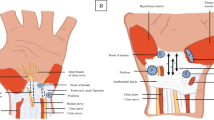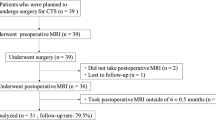Abstract
Purpose
Our aim was to study the dynamics of the post-surgical canal and nerve volumes and their relationships to objective [electromyoneurography (EMNG)] and subjective (pain) outcomes.
Methods
Forty-seven patients with carpal tunnel syndrome (CTS) (median age 52, range 23-75 years) with a prominent narrowing of the median nerve within the canal (observed during carpal tunnel release) were evaluated clinically using EMNG and magnetic resonance imagining (MRI) before and at 90 and 180 days post-surgery.
Results
Canal and nerve volumes increased, EMNG findings improved and pain resolved during the follow-up. Increase in tunnel volume was independently associated with increased nerve volume. A greater post-surgical nerve volume was independently associated with a more prominent resolution of pain, but not with the extent of EMNG improvement, whereas EMNG improvement was not associated with pain resolution.
Conclusions
Data confirm that MRI can detect even modest changes in the carpal tunnel and median nerve volume and that tunnel release results in tunnel and nerve-volume increases that are paralleled by EMNG and clinical improvements. Taken together, these observations suggest that MRI could be used to objectivise persistent post-surgical difficulties in CTS patients.
Level of evidence 3 (follow-up study).




Similar content being viewed by others
References
Scholten RJPM, Mink van der Molen A, Uitdehaag BMJ, Bouter LM, de Vet HCW (2007) Surgical treatment options for carpal tunnel syndrome. Cochrane Database Syst Rev 17(4), CD003905
Fleckenstein JL, James J, Wolfe GI (2002) MRI vs EMG: which has the upper hand in carpal tunnel syndrome? Neurology 58(11):1583–1584
Mogk JP, Keir PJ (2007) Evaluation of the carpal tunnel based on 3-D reconstruction from MRI. J Biomech 40(10):2222–2229
Monagle K, Dai G, Chu A, Burnham RS, Snyder RE (1999) Quantitative MR imaging of carpal tunnel syndrome. Am J Roentgenol 172(6):1581–1586
Bower JA, Stanisz GJ, Keir PJ (2006) An MRI evaluation of carpal tunnel dimensions in healthy wrists: implications for carpal tunnel syndrome. Clin Biomech 21(8):816–825
Pierre-Jerome C, Bekkelund SI, Nordstrom R (1997) Quantitative MRI analysis of anatomic dimensions of the carpal tunnel in women. Surg Radiol Anat 19(1):31–34
Ablove RH, Peimer CA, Diao E, Oliverio R, Kuhn JP (1994) Morphologic changes following endoscopic and two-portal subcutaneous carpal tunnel release. J Hand Surg [Am] 19(5):821–826
Cudlip SA, Howe FA, Clifton A, Schwartz MS, Bell BA (2002) Magnetic resonance neurography studies of the median nerve before and after carpal tunnel decompression. J Neurosurg 96(6):1046–1051
Musluoglu L, Celik M, Tabak H, Forta H (2004) Clinical, electrophysiological and magnetic resonance imaging findings in carpal tunnel syndrome. Electromyogr Clin Neurophysiol 44(3):161–165
Gelberman RH, Pfeffer GB, Galbraith RT, Szabo RM, Rydevik B, Dimick M (1987) Results of treatment of severe carpal-tunnel syndrome without internal neurolysis of the median nerve. J Bone Joint Surg Am 69(6):896–903
Rhoades CE, Mowery CA, Gelberman RH (1985) Results of internal neurolysis of the median nerve for severe carpal-tunnel syndrome. J Bone Joint Surg Am 67(2):253–256
Jablecki CK, Andary MT, So YT, Wilkins DE, Williams FH (1993) Literature review of the usefulness of nerve conduction studies and electromyography for the evaluation of patients with carpal tunnel syndrome. Muscle Nerve 16(12):1392–1414
Bilić R, Kolundžić R, Trkulja V, Crnković T, Vuković A (2006) The carpal tunnel syndrome: medical and economic advantages of well-timed surgical treatment. Lijec Vjesn 128(5-6):143–149
Richman JA, Gelberman RH, Rydevik BJ, Gylys-Morin VM, Hajek PC, Sartoris DJ (1987) Carpal tunnel volume determination by magnetic resonance imaging three-dimensional reconstruction. J Hand Surg [Am] 12(5 Pt 1):712–717
Richman JA, Gelberman RH, Rydevik BL et al (1989) Carpal tunnel syndrome: morphologic changes after release of the transverse carpal ligament. J Hand Surg [Am] 14(5):852–857
Ceruso M, Angeloni R, Lauri G, Checcucci G (2007) Clinical diagnosis. In: Luchetti R, Amadio P (eds) Carpal tunnel syndrome. Springer-Verlag, Berlin, pp 63–68
Britz GW, Haynor DR, Kuntz C, Goodkin R, Gitter A, Kliot M (1995) Carpal tunnel syndrome: correlation of magnetic resonance imaging, clinical, electrodiagnostic, and intraoperative findings. Neurosurgery 37(6):1097–1103
Kato T, Kuroshima N, Okutsu I, Ninomiya S (1994) Effects of endoscopic release of the transverse carpal ligament on carpal canal volume. J Hand Surg [Am] 19(3):416–419
Pasternack II, Malmivaara A, Tervahartiala P, Forsberg H, Vehmas T (2003) Magnetic resonance imaging findings in respect to carpal tunnel syndrome. Scand J Work Environ Health 29(3):189–196
Werner RA, Andary M (2002) Carpal tunnel syndrome: pathophysiology and clinical neurophysiology. Clin Neurophysiol 113(9):1373–1391
Ntahi G, Palmer KT, Linaker C, Harris CE, van der Star R, Cooper C, Coggon D (2013) Symptoms, signs and nerve conduction velocities in patients with suspected carpal tunnel syndrome. BMC Musculoskelet Dis 14:242, http://www.biomedcentral.com/1471-2474/14/242
Author information
Authors and Affiliations
Corresponding author
Ethics declarations
Conflict of interest
Authors have no conflict of interest to declare
Funding
This study received no funding
Ethics
The study was approved by the institutional Ethics Committee
Rights and permissions
About this article
Cite this article
Crnković, T., Trkulja, V., Bilić, R. et al. Carpal tunnel and median nerve volume changes after tunnel release in patients with the carpal tunnel syndrome: a magnetic resonance imaging (MRI) study. International Orthopaedics (SICOT) 40, 981–987 (2016). https://doi.org/10.1007/s00264-015-3052-8
Received:
Accepted:
Published:
Issue Date:
DOI: https://doi.org/10.1007/s00264-015-3052-8




